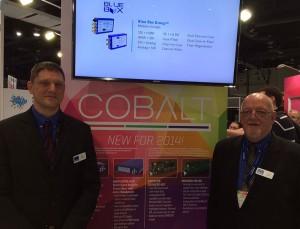NAB Perspectives: Cobalt Digital’s Jungels Talks New Quad-Split and Baseband-to-IP Transition

Cobalt Digital’s booth at NAB 2014 was headlined by a unique quad-split card for OpenGear in sports trucks and control rooms, which allows users to move frames around the display at will — rather than the traditional four-quadrant split.
The 9970-QS quad-split card provides four SDI inputs (3G/HD/SD), all with frame sync and independent ARC capability. Multiple UMD per PiP, user, router source (Utah Scientific integration), and timecode are standard. Other capabilities include highlighted borders, Ethernet, GPI, and serial input for tally, full-screen mode, audio-bar overlay, HDMI/SDI output, and more.
Other major news included an expanded Blue Box Group with another converter and frame sync, a card-based multi-rate distribution amplifier, and significant upgrades to its SPOTCHECK loudness-measurement/compliance-monitoring system. CLICK HERE for Cobalt’s full NAB 2014 product lineup.
SVG took a few minutes with Cobalt Digital VP of Engineering Nick Jungels to discuss the new quad-split, the company’s other offerings at NAB 2014, and how Cobalt is addressing the potential move from baseband to IP workflows.
First things first, what is getting the most attention at the booth this year?
Our major new product for sports is a quad-split. Most four-input multiviewers have a quad-split that is fixed, but [the 9970-QS] allows you to customize and move around the four areas throughout the screen. You can resize each quad and move it anywhere on the screen.
We gave a private screening to one of our larger customers. He said it was going to make things so much easier because it would allow the operator to arrange the [display] how they want instead of reading a manual or calling him over to configure it. It’s very straightforward: you just move around the sliders and save it.
Much of the buzz at the show this year has revolved around the move from baseband to IP-based workflows. Are you seeing this transition take place, and what role is Cobalt playing in that?
It’s definitely coming. The real question is how soon and how much. You can’t ignore SMPTE [Standard ST] 2022 and how it’s going to affect the move to IP. It is going to happen; it’s just a question of how long that transition period will last and when we want to engage. I don’t think trucks will move as fast as fixed installs on the 2022 transition. The biggest thing is whether the cost can be controlled because, right now, IP investment is a lot more expensive.
How can Cobalt help its customers make the IP transition while still supporting its current baseband needs?
There will be inefficiencies at the boundaries, and, wherever the inefficiencies are, there will be an opportunity for someone to solve a problem. We will definitely play a role in the glue that bridges baseband to Ethernet or IP-based products.
It’s going to be interesting how that all progresses. You are going from a dedicated wire that you can unplug and plug back in if something goes wrong. It either works or it doesn’t; there is a comfort there for a lot of people. Then you go to an ephemeral world with packets, and I think that is going to be a hard transition for people in high-pressure situations like live sports. If something dumps out, you have to figure it out right now how to fix it.
And what about live 4K production? We are obviously a long way from an end-to-end 4K production, but have you seen a rise in interest in 4K from your customers?
We have started to get more requests for gear that supports 4K, like downconverters and color correctors. But, at the same time, it’s just one point in a long chain that has supported that huge data rate. Then you throw in whether or not to do 6-gig or 12-gig. And then how do you get it to the home?
I would say, in two to three years, we will start to see real 4K equipment and workflows. But right now, I just can’t imagine people being OK with quad wires for one signal. That is a lot of density, considering the big trucks are now running 1000- or 2000-squared routers. Now imagine quartering that. It’s a tough sell.